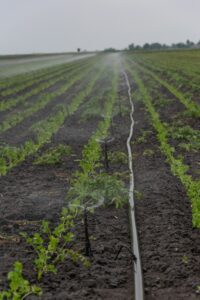he world’s agricultural sector faces significant challenges, from climate change to water scarcity and the ever-growing demand for food. In such a critical scenario, innovation in irrigation techniques has become indispensable. Among these, drip irrigation systems have emerged as a game-changer, offering a sustainable solution to optimize water usage while enhancing agricultural productivity.
This article explores the fundamentals of the drip irrigation system, its benefits, and its vital role in shaping the future of agriculture.
What is Drip Irrigation?
Drip irrigation, also known as micro-irrigation, is a water-saving technique that delivers water directly to the roots of plants in a slow and controlled manner.
This is achieved through a network of valves, pipes, tubing, and emitters. The water is released drop by drop, ensuring minimal wastage through evaporation or runoff.
This system stands in contrast to traditional irrigation methods such as flood or sprinkler irrigation, which tend to consume vast amounts of water and are often less efficient in arid and semi-arid regions.
The Mechanics of Drip Irrigation
The drip irrigation system comprises the following components:
- Water Source: This can be a borewell, river, or reservoir.
- Pump Unit: Ensures water reaches the system with adequate
pressure. - Filtration Unit: Removes impurities to prevent clogging of emitters.
- Mainline and Sub-mainline Pipes: Distribute water across the field.
- Emitters/Drippers: These are small devices that release water at a specific rate to individual plants.
- Valves and Controllers: Regulate water flow and automate irrigation schedules.
The setup can be tailored to various types of crops, soil conditions, and field sizes, making it a versatile choice for farmers worldwide.
The Benefits of Drip Irrigation
1. Water Conservation
Water scarcity is one of the most pressing global challenges, with agriculture accounting for 70% of freshwater usage. Drip irrigation significantly reduces
water consumption by delivering water only where and when it is needed. Studies suggest it can save up to 50-70% more water compared to conventional methods.
2. Enhanced Crop Yield and Quality
By maintaining optimal soil moisture levels, drip irrigation creates a conducive environment for plant growth. It reduces water stress and ensures uniform distribution, resulting in higher crop yields and better-quality produce.
3. Weed and Pest Control
Since water is applied directly to the roots, areas between plants remain dry, limiting the growth of weeds and reducing pest infestations. This translates to lower usage of herbicides and pesticides, making farming more eco-friendly.
4. Adaptability to Various Terrains
Drip irrigation is particularly effective in areas with uneven terrain or sandy soils where traditional irrigation methods may struggle. Its adaptability allows farmers in hilly or arid regions to cultivate crops successfully.
5. Cost Efficiency
While the initial setup costs can be high, the long-term benefits—reduced water bills, lower labour costs, and increased crop productivity—make drip irrigation a cost-effective solution for farmers.
Challenges of Drip Irrigation
Despite its many advantages, drip irrigation has some limitations:
- High Initial Investment: The setup requires a significant financial outlay, which can be a barrier for small-scale farmers.
- Maintenance Requirements: Regular cleaning of filters and emitters is essential to prevent clogging.
- Technical Knowledge: Farmers need proper training to operate and maintain the system efficiently.
However, these challenges are surmountable with government support, subsidies, and awareness campaigns.
The Importance of Drip Irrigation for the Future of Agriculture
The role of drip irrigation in securing the future of agriculture cannot be overstated. Here’s why it is indispensable:
1. Addressing Water Scarcity
As the global population rises, the demand for water will intensify. Drip irrigation offers a sustainable solution to optimise water usage, particularly in
water-stressed regions.
2. Climate Resilience
With unpredictable rainfall patterns and rising temperatures due to climate change, farmers need resilient systems that ensure consistent crop production. Drip
irrigation helps mitigate the impact of these challenges by providing controlled irrigation, irrespective of external conditions.
3. Food Security
By enhancing crop yields and enabling year-round farming, drip irrigation contributes significantly to food security. It allows farmers to produce more with less,
meeting the demands of a growing global population.
4. Supporting Sustainable
Agriculture
Sustainability is the need of the hour. Drip irrigation minimises resource wastage and promotes environmentally friendly farming practices. It aligns with global
goals to reduce the agricultural sector’s carbon and water footprints.
5. Boosting Farmer Livelihoods
Improved productivity and reduced costs directly impact farmers’ incomes. Drip irrigation empowers smallholders and large-scale farmers alike, enabling them
to thrive in competitive markets.
Success Stories
Countries like Israel and India have set remarkable examples in adopting drip irrigation systems. Israel, a pioneer in water management, has transformed its arid lands into fertile agricultural fields using advanced drip irrigation techniques.
In India, the government promotes micro-irrigation systems, benefiting millions of farmers and increasing water-use efficiency. Such initiatives highlight the potential of drip irrigation in revolutionizing agriculture globally.
How to Make Drip Irrigation More Accessible
To ensure widespread adoption, the following steps are essential:
- Government Incentives: Subsidies and low-interest loans can help farmers afford the initial investment.
- Awareness Campaigns: Educating farmers about the benefits and operational aspects of drip irrigation is crucial.
- Technological Innovations: Simplifying the design and lowering costs through innovation will make it more accessible.
- Collaborations: Partnerships between governments, NGOs, and private companies can accelerate adoption rates.
Conclusion
Drip irrigation system is more than just a technological advancement; it is a paradigm shift in the way we think about water and agriculture. By optimizing resources,
improving productivity, and fostering sustainability, this system holds the key to addressing the challenges of modern agriculture.
As we move towards a future marked by increased environmental and economic pressures, the adoption of drip irrigation systems is not just desirable—it is imperative. Investing in this technology today will ensure a more resilient, productive, and sustainable agricultural sector for generations to come.
By prioritizing solutions like drip irrigation, we can turn challenges into opportunities and pave the way for a greener, more secure future.

